Renoir, Dog-Pee Stains, and Sultry Children’s Portraits—Newport’s Mansions Are a Treasure Hunt for the Nosy
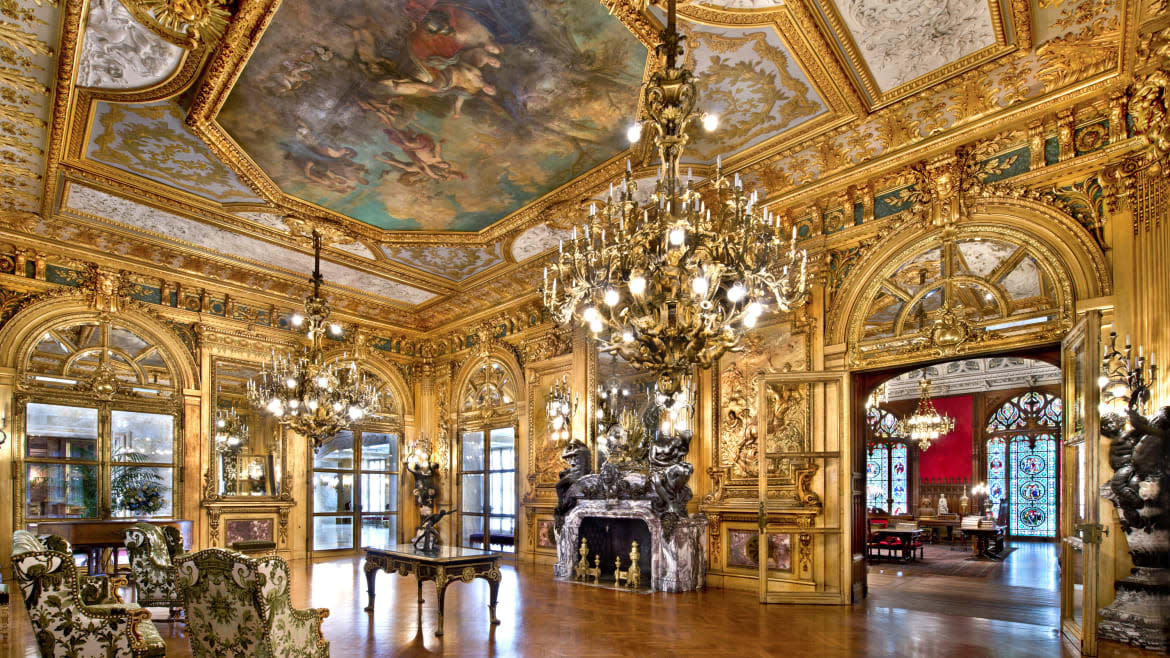
The path from gaudy room to gaudy room in Newport’s mansions is often lined with rubber-bottom mats, but they might as well be conveyor belts. Millions of tourists pass through the fabled halls of the Breakers, Rough Point, Rosecliff, Marble House, and the rest, but passing through is often all they do. Necks craned, phone snapping, tongues wagging, they might stop… to wait for somebody to get out of their shot.
Frankly, though, who can blame them? These places were built to wow, to fill visitors to the brim with awe sufficient to almost convince a visitor that the owners of these Rhode Island mansions truly were aristocrats. So you have salons that look like Midas had an orgy, dining rooms that must have left marble quarries barren, festooned ballrooms, and all at knee-buckling scale. It’s simply a lot to take in.
But in an era where there was so much money you really could buy anything except happiness (many owners were deeply unhappy people), I’ve always wandered in and wondered at what these people bought. What trinkets did they surround themselves with? So this summer I flitted from house to house with one goal in mind. To see what many of us might overlook going through these houses on cruise control.
When visiting Newport and keen on seeing what one of the richest people in the world would surround themselves with, you’re best starting at Rough Point. It’s the most personal of the impersonal palatial homes because it’s largely untouched since its last owner, Doris Duke, lived in it.
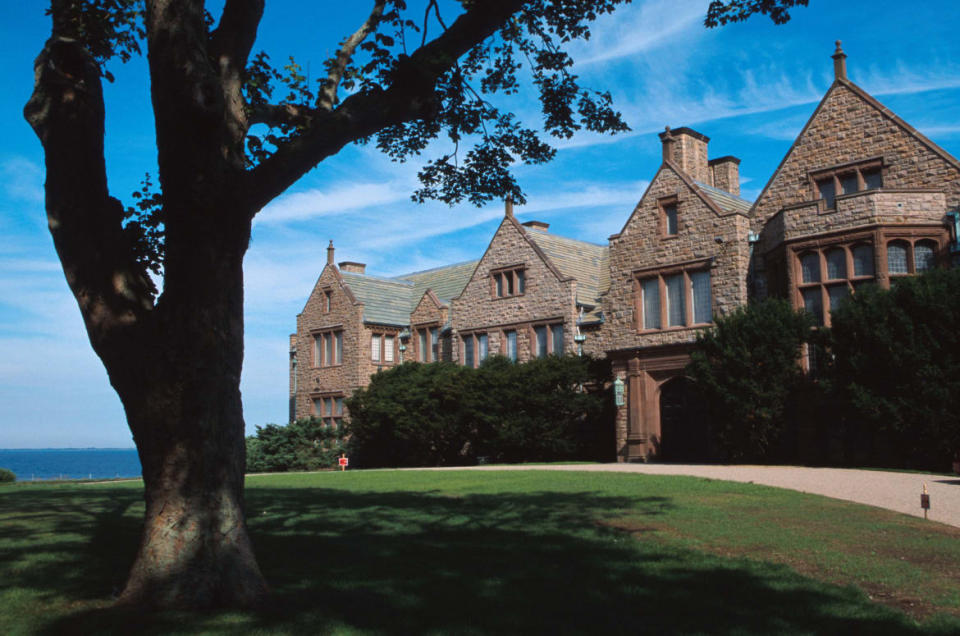
Obscured from the Bellevue Avenue, it’s easily missed, as tourists often seem to do, so it’s rarely crowded. First, take in the details from outside. Three of the greatest architectural firms in history—Peabody & Stearns, John Russell Pope, and Horace Trumbauer—left their mark on this English manor ensconced against the open Atlantic Ocean. The grounds were laid out by Central Park co-creator Frederick Law Olmsted.
Duke was once believed to be the richest woman in the world and was a tabloid figure most of her life, an isolating reality she could do little about. Her gilded life in the Depression was gobbled up by literally hungry masses and her romantic life was given lurid treatment (she was linked to General Patton, Duke Kahanamoku, Porfirio Rubirosa, and others). Her life had multiple tragic turns, including running over and killing her friend and decorator at this very house (ruled an accident) and the estrangement of the woman she adopted as an adult (the sister-in-law of billionaire Nelson Peltz, whose daughter just married Brooklyn Beckham).
Poking around her house, there are objects both precious and mundane worth paying attention to. But, before you look around…
“I don’t think people look up,” observed Eric Greenberg, the director of museums for the foundation Duke left behind, who agreed to show me around. The ceilings are elaborate works in pressed plaster, commissioned by the Dukes when they had the ceilings lowered.
While there are expensive Old Master paintings and tapestries on the walls throughout, to get a better sense of Duke, you might need to set your gaze a little lower. Take the Solarium, for example, which is one of Newport’s most spectacular rooms with views of the ocean pouring in arched windows on three sides. The thing to notice here is actually on the back of dog hair-covered couches. There, the astute observer might see, are dog-pee stains that Duke never bothered to have removed.
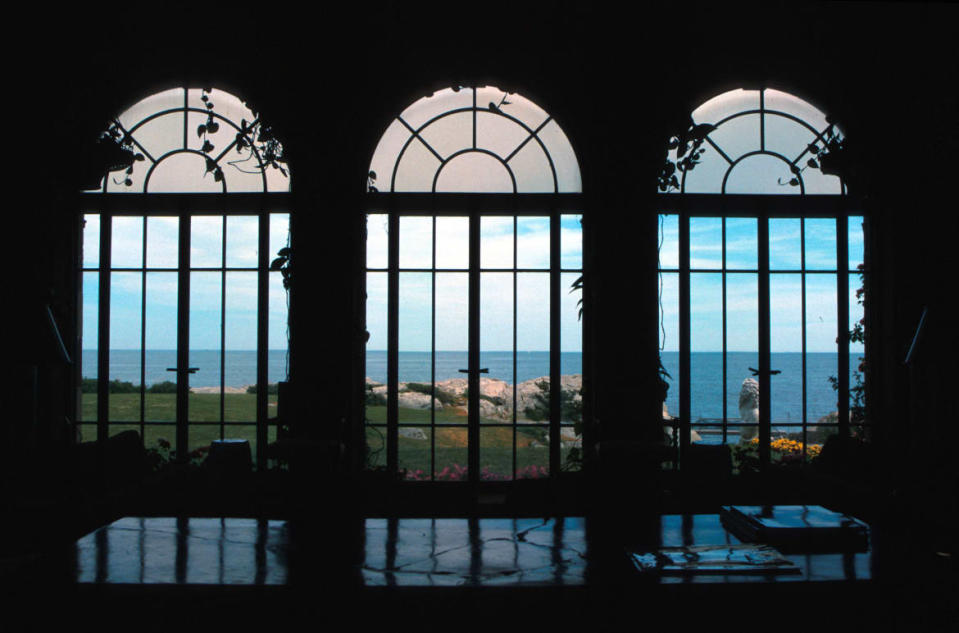
Speaking of her dogs, Duke’s devotion to restoration and preservation wasn’t limited to the hundreds of colonial houses she saved in Newport. Peer closely at vases you see throughout her house: By necessity, Duke herself became an expert at restoring broken pottery thanks to her pups.
If you, like Duke, could decorate your bedroom with money of no concern, what would you do? In her case the result is one of Newport’s most iconic, wild, and, yes, kind of tacky bedrooms where the Age of Reagan meets the Gilded Age. Overlooking the Cliff Walk and Atlantic Ocean, it’s bathed in lemon yellow walls, royal purple curtains and upholstery, and filled with furnishings covered in mother of pearl. Once you’ve taken that all in, look above the mantle. Hanging there is a beautiful Renoir that captures a young woman lost in her needlework, her shirt slipping off her shoulder. It is a painting that, hung anywhere, would be lovely, but here amidst all the bold decoration, it is just downright exquisite.
Rough Point is operated by Newport Restoration Foundation, but most of the famous mansions here are under the auspices of the Newport Preservation Society. These often were rescued before they were razed, so many of the belongings of the families living in them are long gone. Only a few, Kingscote and Chateau-Sur-Mer among them, have intact collections, and the Breakers and Marble House have a fair amount of their original furnishings. The Elms and Rosecliff, on the other hand, have very little.
If you happen to be visiting Newport in the next month, though, you’re in luck. Not only are late September and October the loveliest time of year but there is a fabulous exhibition on at Rosecliff titled “Anything You Want: A Closer Look at Treasures from Newport’s Gilded Age.”
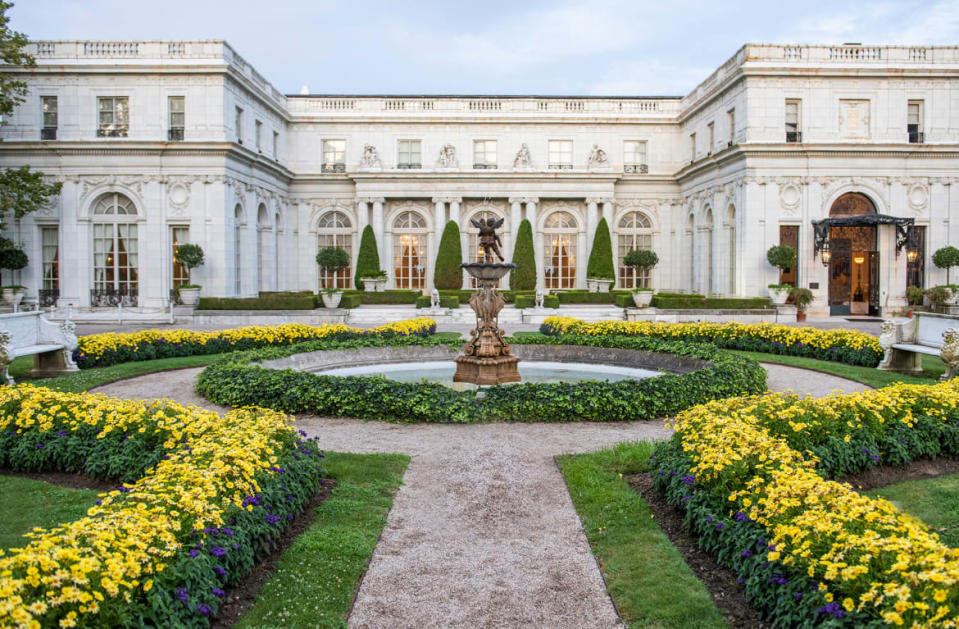
Rosecliff was built by Tess Oelrichs, one of the “Triumvirate” who ruled high society after Mrs. Astor’s decline around the end of the 19th century. Clad in gleaming white terracotta, it was designed by Stanford White. Of all the town’s grand mansions, this is the one that looks most meant for partying–and it was. While there are only a few pieces in the house from when Oelrichs reigned, up its famed heart-shaped staircase one can find the exhibition.
Right after walking in you’re confronted with an object from Marble House you might normally miss–which is understandable since it’s generally considered the most lavishly decorated house ever in the U.S. It’s a portrait of Harold Vanderbilt, the son of William K. and Alva Vanderbilt (another piece of that Triumvirate). His parents hired the French painter Charles Joshua Chaplin to depict their adolescent son, and given that Chaplin was best known for painting women in various stages of undress, Harold ends up looking both feminine and sultry. Of course, how boys were dressed and depicted was dramatically different a century and a half ago, and one could take this painting as an opportunity to dive into that.
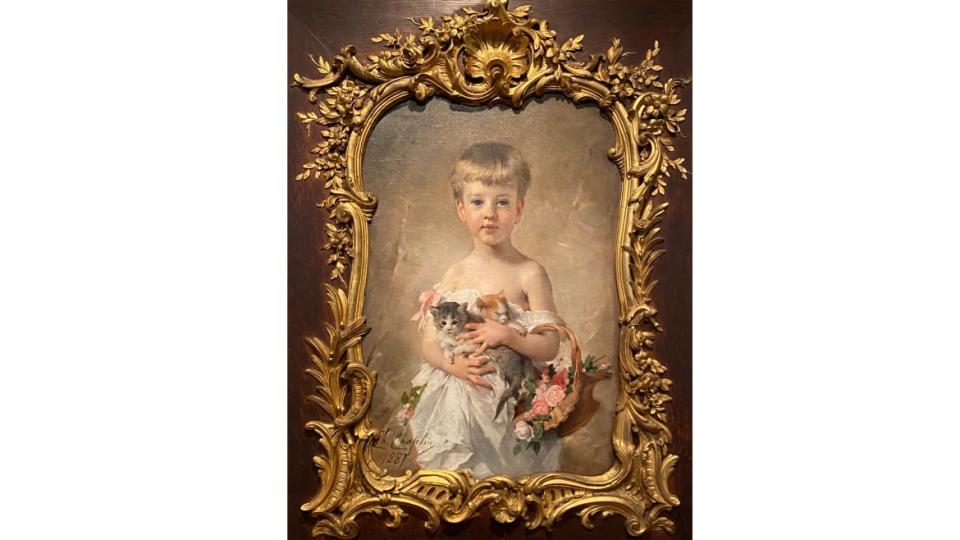
Fans of HBO’s The Gilded Age show can see an ebonized mahogany dressing table that belonged to Mrs. Astor. Fittingly it is usually housed in Chateau sur Mer, the mansion used by the show as a stand-in for Mrs. Astor’s Beechwood. Beechwood, designed by Central Park’s other co-creator, Calvert Vaux, is currently owned by Larry Ellison. The exhibition also contains a bust fit for a conquering emperor that sculptor Hiram Powers made of the originator of the Vanderbilt fortune, Cornelius Vanderbilt. Indeed it was modeled after busts of Alexander the Great. It normally stands in the Great Hall in the Breakers, where it might be passed by unnoticed, but here you can take in all of its pomposity up close. Speaking of pomposity, from the Marble House branch of the Vanderbilts you’ll get a close look at the solid bronze dining chairs that Alva commissioned, which needed to be moved by a male servant, as well as a pair of fanciful Rococo gold candleholders she had made when she moved across the street to Belcourt.
The most romantic interior of the Preservation Society houses is probably found at Kingscote, whose moody Gothic Revival interiors were given a once over by the flamboyant Stanford White. The house reopens in October but my favorite object in its collection is in this exhibition: a dazzling center table of carved rosewood with a top made up of a swirl of unevenly-cut stone tiles with a micro-mosaic in the center depicting Roman ruins.
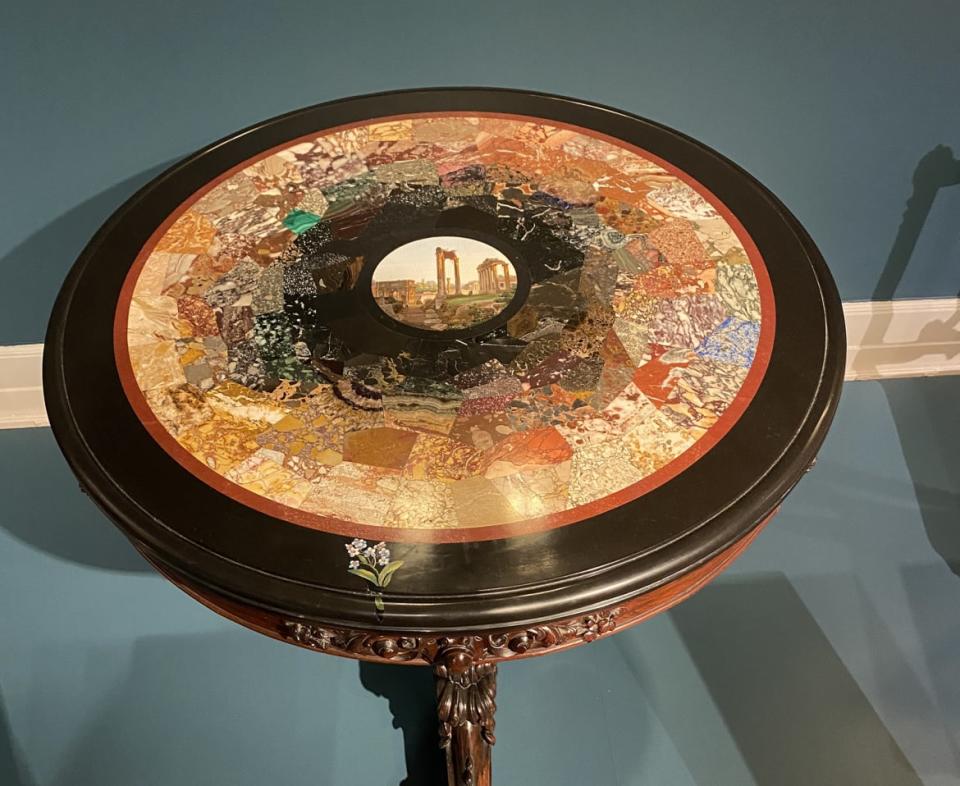
The exhibition also addresses a question I’ve long wondered–did these newly wealthy buyers care about their furnishings having a history or did they also just need them to ape European designs? The answer is, well, both. There are pieces that were made by American furniture manufacturers that replicated historic European pieces, such as the dramatic ebonized wood and gilded bronze cabinet the decorator Jules Allard & Sons made based on designs by the great André-Charles Boulle. “For many of Allard’s American clients,” the exhibition notes, “looking old was all that mattered.”
But there are also pieces like Harold Vanderbilt’s chest of drawers that is an original by Jean-Francois Oeben, a favorite of none other than Madame de Pompadour. Especially fascinating are the pieces that represented these Americans wanting European art, but their way. And so you have the ebony, brass, tortoiseshell, and gilded bronze tall-case clock attributed to Boulle that Allard added to by plopping a gilded bronze baby with a melting face on top!
Many of the most elaborate objects in the exhibition come from Marble House, which is next door. Popping into this excessive show palace, I catch the one detail that always grabs my eye. In the entrance hall covered in yellow marble, there’s a giant Venetian glass mirror with a dark black stone basin. Look at the bottom: Streaming out of the face’s mouth is a cascade of glass water, frozen for eternity.
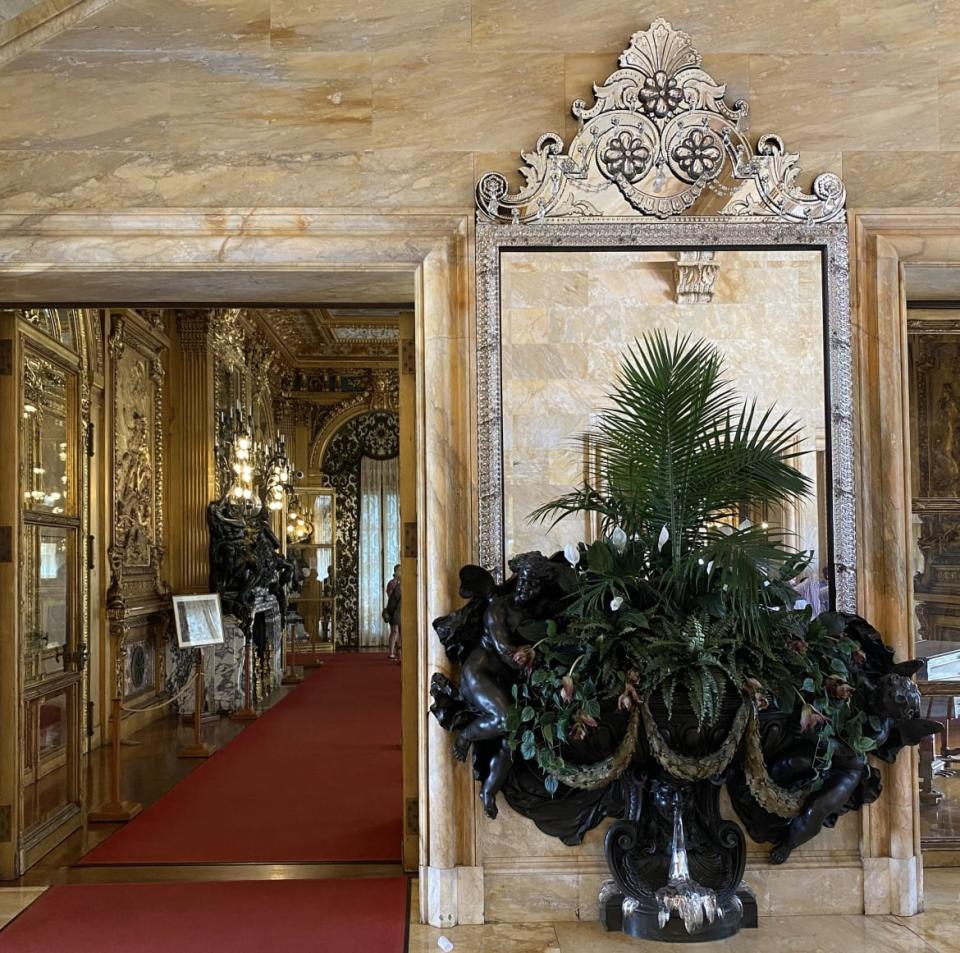
If you work your way back up Bellevue Avenue towards town, you’ll hit the Elms, a French Neoclassical mansion built for the coal titan Edwin J. Berwind by Horace Trumbauer. “The Crucial Battle of Modern Newport,” blared a 1962 New York Times headline–it was the dismembering of the Elms that galvanized many a wealthy family here to worry about preserving collections. While some of the pieces that were sold have been bought back, the rooms here are mostly filled with pieces the Society felt were ones that could be found in a house such as this.
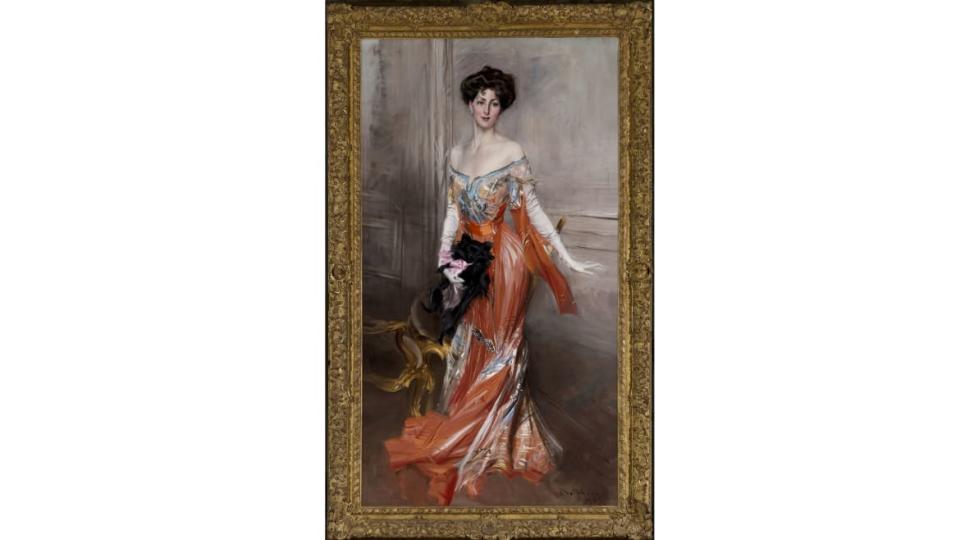
Whatever you do, don’t miss one of those stand-in pieces—the Boldini portrait hanging in the ballroom of Elizabeth Drexel Lehr. Giovanni Boldini was the greatest of global high society’s portraitists (sorry, Sargent) albeit a monster. He would make women who were probably already starving lose even more weight before he would paint them. This portrait is the master in all his dashing style with dramatic elongated Mannerist lines, vibrant colors, and almost violent brushstrokes on garments that give the whole piece movement. The subject was one of the Gilded Age’s sadder figures. She was married to society’s “court jester” Harry Lehr, who told her after the wedding that he, a gay man, only married her for her money and would never touch her.
While the audio guide here is thoroughly modern, one of the charming things in the home are the placards with fancy script that I’m guessing have been around for decades, and I hope they never get rid of them. One can be found upstairs informing us in dramatic prose that the pillows in the beat-up glass display case were from the pavilion used by Marie Antoinette when she met her future husband, Louis XVI.
The most famous Newport mansion is the Breakers, but while it’s the most visited, it’s not the one people fall in love with. Indeed, I’m not sure it was ever loved, even by its builder who wanted a Shingle Style villa and ended up with a towering stone edifice. Impressive? Most certainly. But it’s just… so big. While there are many wonderful objects left behind by the last Vanderbilts, there are two things I think worth paying special attention to.
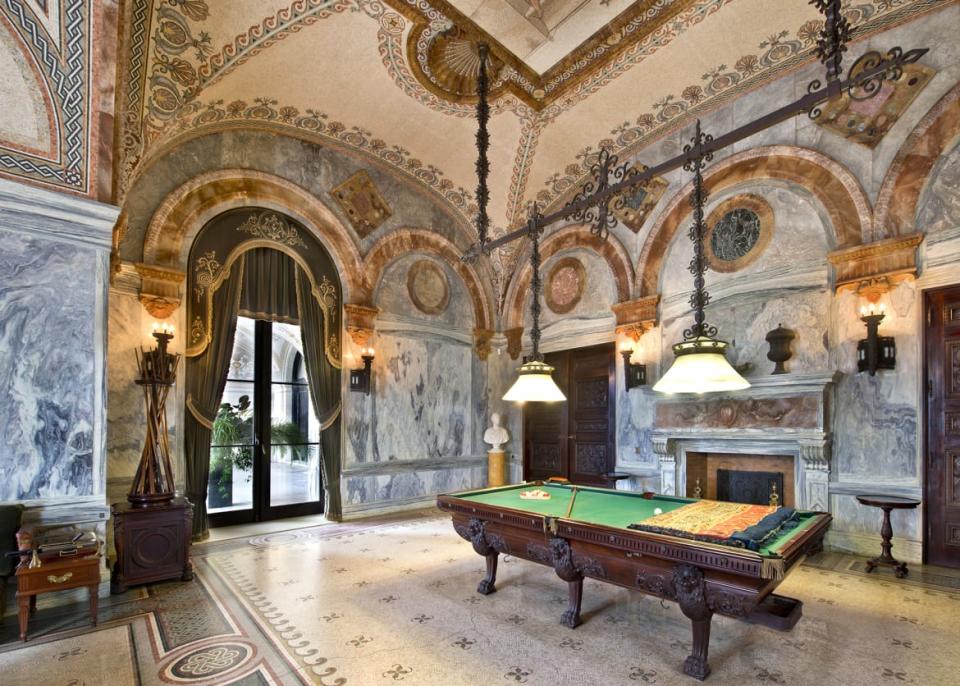
The first is the Billiard Room. Even architectural critics who lampooned the Breakers and all it stood for make sure to note that this room stood apart. Take a moment here to marvel at the elegance and delicacy that Richard Morris Hunt achieved with marble veneer—no mean feat in this mansion and in a room type usually weighed down by solemn masculinity.
The second can be found in the Music Room behind a glass wall. It’s a console table from the famed Gallery in the Borghese Palace in Rome, and some would argue that it is the most important piece of Italian furniture in the U.S. It was part of a set of four made to represent each of the seasons, with the one here representing Winter. It was designed by the sculptor Vincenzo Pacetti with masters working in bronze, marble, and micromosaic forging its components. Stand on your tippy toes and try to catch a glimpse of its top, a Rorschach butterfly of bilaterally symmetrical black and white Aquitaine marble pieces.
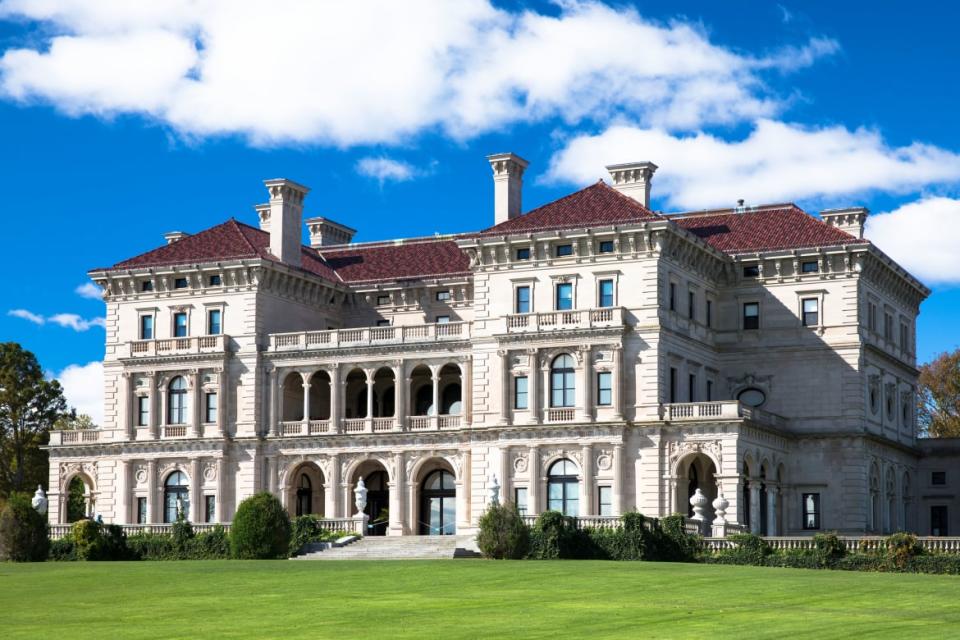
The polar opposite of the Breakers can be found up the road and across a bridge in Bristol. Blithewold is an English Manor Revival mansion overlooking Narragansett Bay that was built by the Van Wickles, who made their money in coal. Everything here is comfortable, but when you walk in you’re faced with an item that also came from the famed Borghese Palace, this time a Flemish tapestry depicting a scene from Dante. Also in the entrance hall is a box bed which looks like a cupboard but you’d actually sleep in there. It was often used to provide separation from animals, domesticated and wild, and to sleep sitting up because of respiratory issues.
Upstairs, fans of marquetry will love the master bedroom as nearly every piece is some elaborate work in that intricate decorative style. Since the family left their possessions to the house museum, the collection also includes a significant amount of clothing, pieces of which are rotated out on display. Today most of us only know the designers whose names continue to grace shops on our streets, but note the dressmakers here. One family favorite was Fox, which was a shop based in New York created in 1885 by four sisters. They never put a sign on the door, never advertised, never accepted new clients without referral, and never accepted a client from a profession like the theater!
I’ll never forget a few years ago when I had a couple of friends visiting so I dropped them off at the Breakers. Thinking I had at least an hour, I headed over to tour Isaac Bell House. A mere twenty minutes later I got a text–”We’re done! Ready to be picked up when you can.” I couldn’t believe it. They’d gone through, taken their pics for social media, and come back out. If, after reading this, you still don’t feel compelled to be especially nosy in each of these houses, that’s totally OK. But try to do better than my friends.
Get the Daily Beast's biggest scoops and scandals delivered right to your inbox. Sign up now.
Stay informed and gain unlimited access to the Daily Beast's unmatched reporting. Subscribe now.

